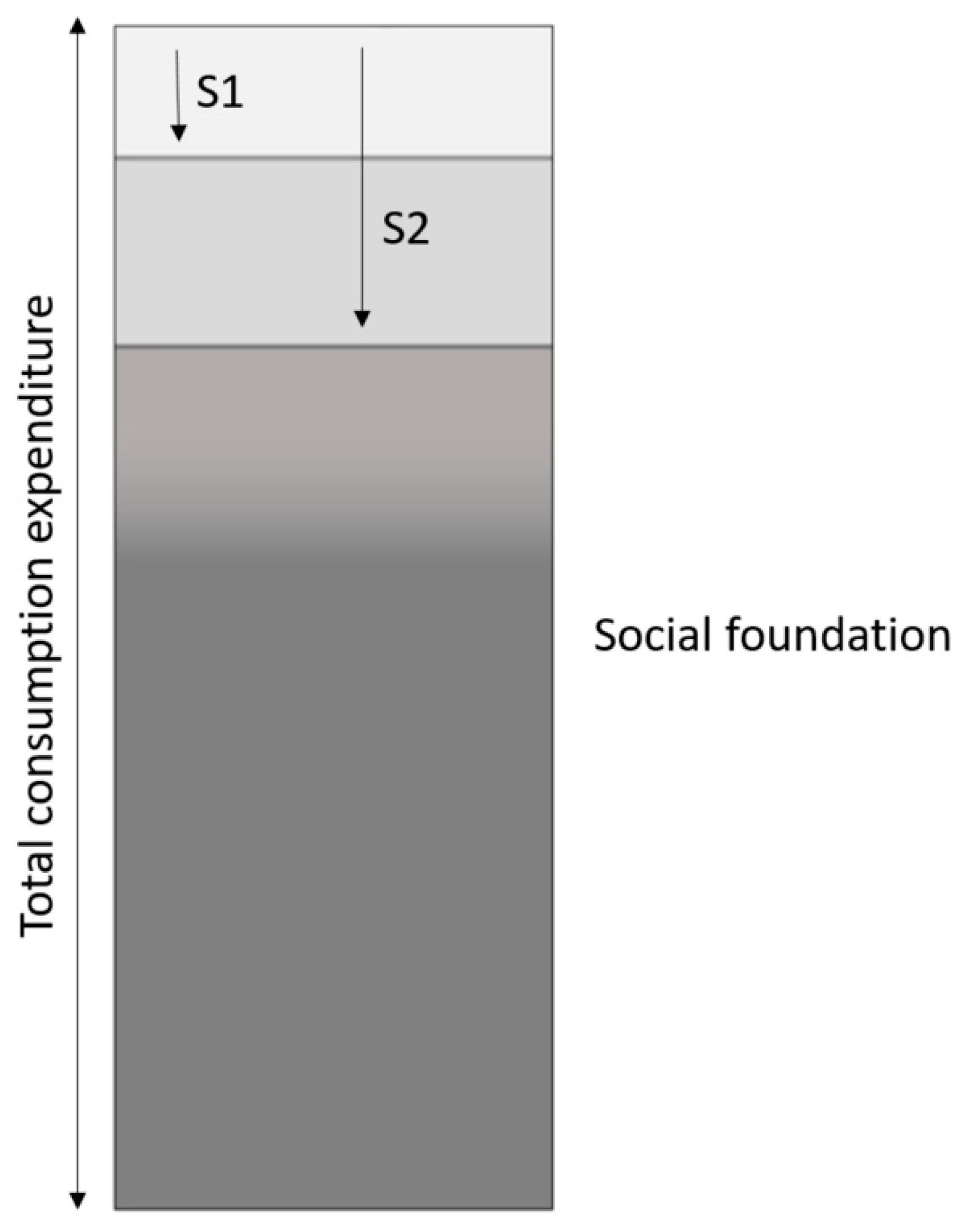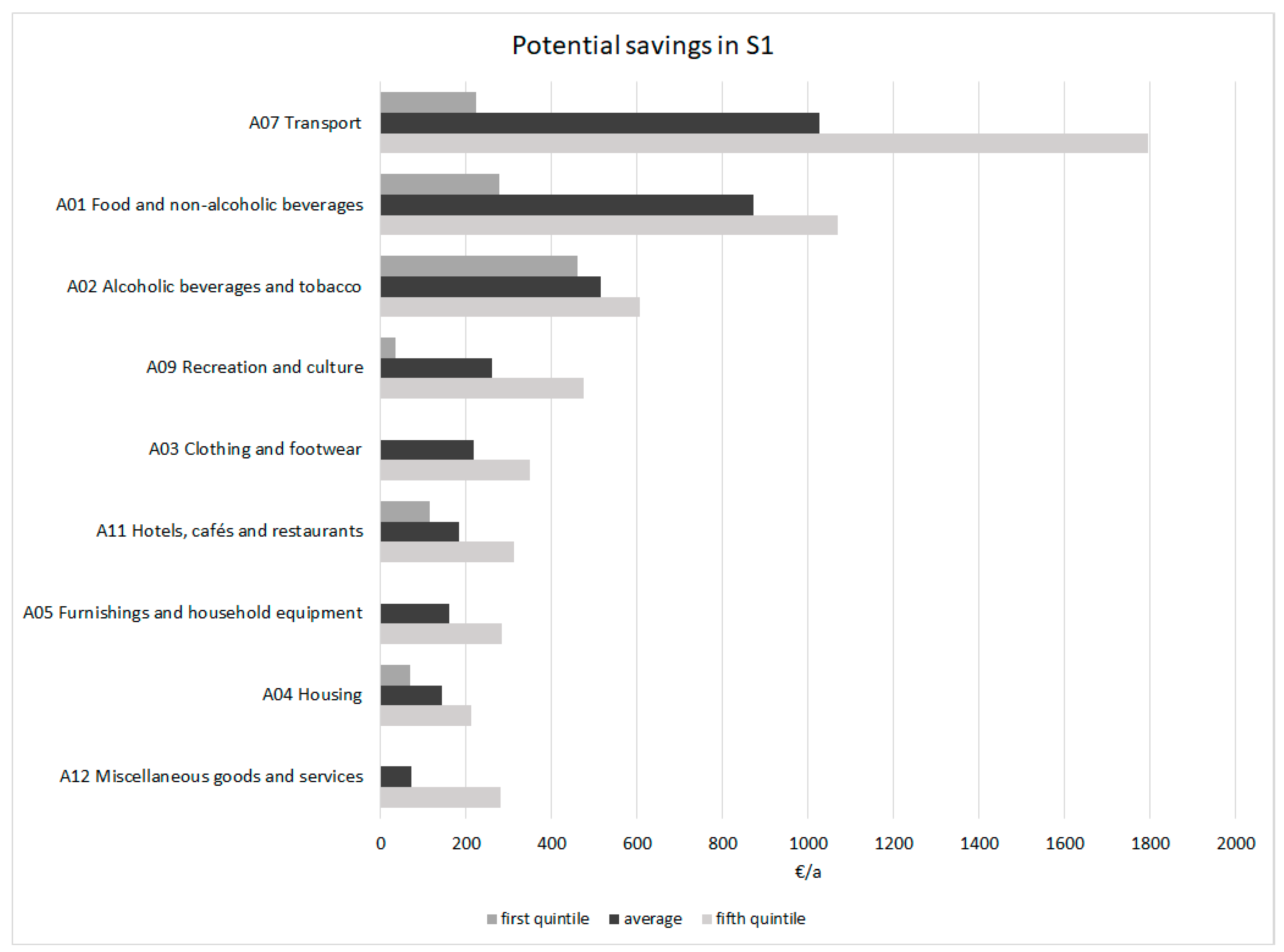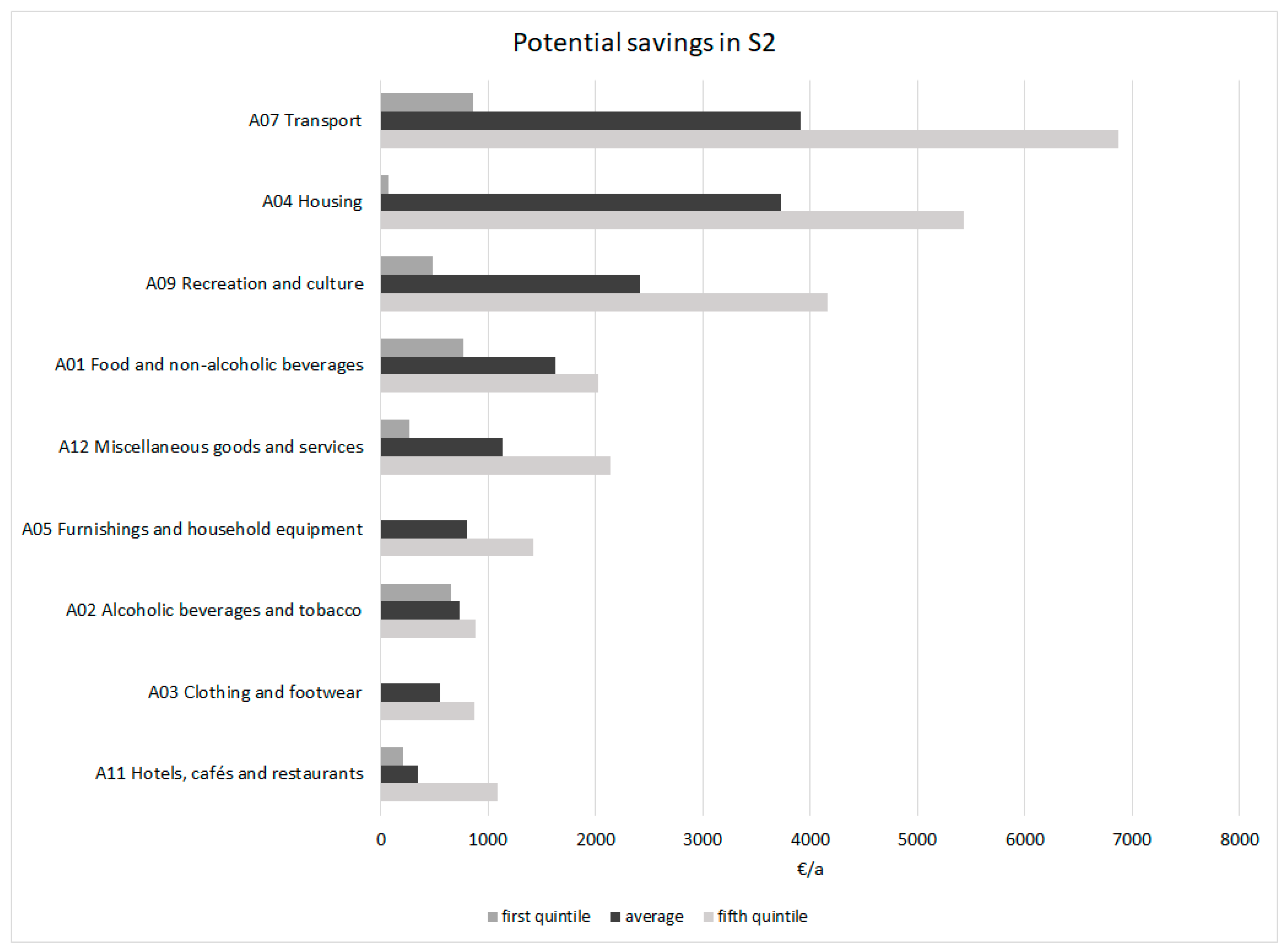The Economic Potential to Support Sustainability through Household Consumption Choices
Abstract
1. Introduction
- How much an average Finnish household could reduce its consumption of disposable income by reducing unnecessary consumption while simultaneously reducing the environmental impact?
- What is the economic potential for making sustainable consumption choices in Finland?
2. Materials and Methods
2.1. Background Information
2.2. Data Collection
2.3. Calculation Model
- Scenario 1 (S1) describes an incremental situation which may be achieved quickly and easily over the next couple of years. In S1, the savings can be reached with rather simple and small actions, and a radical change of lifestyle is not required. These small actions include for example reducing the consumption of meat and reducing household energy consumption by performing small energy-saving actions.
- Scenario 2 (S2) is a long-term-goal scenario, which is also realistic provided that Finnish society is ready to implement fundamental changes. To be able to achieve the S2 situation, considerable willingness and action to shift towards more sustainable lifestyles would also be required globally. In S2, the ceiling of the social foundation is not risked, but almost all unnecessary consumption has been cut out. S2 may be viewed as describing the target for the next 15–20 years, as it requires significant changes at many societal levels.
3. Results and Discussion
4. Conclusions
Supplementary Materials
Author Contributions
Funding
Acknowledgments
Conflicts of Interest
References
- Le Quéré, C.; Andrew, R.M.; Friedlingstein, P.; Sitch, S.; Pongratz, J.; Manning, A.C.; Korsbakken, J.I.; Peters, G.P.; Canadell, J.G.; Jackson, R.B.; et al. Global Carbon Budget 2017. Earth Syst. Sci. Data 2018, 10, 405–448. [Google Scholar] [CrossRef]
- Energy Sector’s Carbon Emissions to Grow for Second Year Running. Available online: https://www.theguardian.com/environment/2018/oct/08/energy-sector-carbon-emissions-grow-second-year-climate-change-coal (accessed on 25 October 2018).
- Figueres, C.; Schellnhuber, H.J.; Whiteman, G.; Rockström, J.; Hobley, A.; Rahmstorf, S. Three years to safeguard our climate. Nature 2017, 543, 593–595. [Google Scholar] [CrossRef] [PubMed]
- UNFCCC. Adoption of the Paris Agreement. Available online: http://unfccc.int/resource/docs/2015/cop21/eng/l09.pdf (accessed on 25 September 2017).
- Claudelin, A.; Uusitalo, V.; Pekkola, S.; Leino, M.; Konsti-Laakso, S. The Role of Consumers in the Transition toward Low-Carbon Living. Sustainability 2017, 9, 958. [Google Scholar] [CrossRef]
- Lindgreen, A.; Hingley, M.K.; Angell, R.J.; Memery, J. A Stakeholder Approach to Managing Food: Local, National and Global Issues, 1st ed.; Routledge: Abingdon, ON, Canada; New York, NY, USA, 2017; ISBN 978-1-315-26526. [Google Scholar]
- Xia, T.; Zhang, Y.; Braunack-Mayer, A.; Crabb, S. Public attitudes toward encouraging sustainable transportation: An Australian case study. Int. J. Sustain. Transp. 2017, 11, 593–601. [Google Scholar] [CrossRef]
- Fitzpatrick, M. Obstacles to Going Green: Survey Results! What Prevents You from Being More Green? Available online: http://www.keenforgreen.com/obstacles-to-going-green-what-prevents-you-from-being-green (accessed on 13 September 2017).
- 4 in 5 Consumers Think Eco-Friendly Products Cost More “Green”. Available online: http://retailmenot.mediaroom.com/2015-04-07-4-in-5-Consumers-Think-Eco-Friendly-Products-Cost-More-Green (accessed on 13 September 2017).
- Inter IKEA Systems B.V. Climate Action Starts at Home—Climate Action Research Report 2018. Available online: https://www.ikea.com/ms/en_US/pdf/reports-downloads/IKEA Climate Action Report 20180906 (002).pdf (accessed on 26 October 2018).
- Leviston, Z.; Greenhill, M.; Walker, I. Australian Attitudes to Climate Change and Adaptation: 2010–2014; CSIRO: Canberra, Australia, 2015. [Google Scholar]
- Dryzek, J.; Norgaard, R.; Schlosberg, D. Climate Change and Society: Approaches and Responses. In The Oxford Handbook of Climate Change and Society; Dryzek, J., Norgaard, R., Schlosberg, D., Eds.; Oxford University Press: Oxford, UK, 2011; ISBN 9780199566600. [Google Scholar]
- Van der Linden, S.; Maibach, E.; Leiserowitz, A. Improving Public Engagement with Climate Change: Five “Best Practice” Insights from Psychological Science. Perspect. Psychol. Sci. 2015, 10, 758–763. [Google Scholar] [CrossRef] [PubMed]
- Statistics Finland. Greenhouse Gas Emissions Caused by Households’ Consumption Have Decreased. Available online: http://tilastokeskus.fi/til/ktutk/2012/ktutk_2012_2014-10-07_tie_001_en.html (accessed on 25 September 2017).
- Seppälä, J.; Mäenpää, I.; Koskela, S.; Mattila, T.; Nissinen, A.; Katajajuuri, J.; Härmä, T.; Korhonen, M.; Saarinen, M.; Virtanen, Y. An assessment of greenhouse gas emissions and material flows caused by the Finnish economy using the ENVIMAT model. J. Clean. Prod. 2011, 19, 1833–1841. [Google Scholar] [CrossRef]
- Lorek, S.; Trotta, G. Consumers and Energy Efficiency—Country Report Finland. An Inventory of Policies, Business and Civil Society Initiatives, Focusing on Heating, Hot Water and the Use of Electricity. 2015. Available online: http://www.utu.fi/en/units/euforie/Research/deliverables/country-reports/PublishingImages/Pages/home/EUFORIE%20D%205%201%20%20Country%20Report%20Finland.pdf (accessed on 25 September 2017).
- United Nations. Agenda 21: Programme of action for sustainable development: Rio declaration on environment and development. In Proceedings of the Statement of Forest Principles the Final Text of Agreements Negotiated by Governments at the UN Conference on Environment and Development (UNCED), Rio de Janeiro, Brazil, 3–14 June 1992; Department of Public Information: New York, NY, USA, 1992. Available online: https://sustainabledevelopment.un.org/content/documents/Agenda21.pdf (accessed on 25 September 2017).
- Kok, R.; Benders, R.M.J.; Moll, H.C. Measuring the environmental load of household consumption using some methods based on input-output energy analysis: A comparison of methods and a discussion of results. Energy Policy 2006, 34, 2744–2761. [Google Scholar] [CrossRef]
- Kerkhof, A.C.; Nonhebel, S.; Moll, H.C. Relating the environmental impact of consumption to household expenditures: An input-output analysis. Ecol. Econ. 2009, 68, 1160–1170. [Google Scholar] [CrossRef]
- OECD Stat. 5. Final Consumption Expenditure of Households. Available online: https://stats.oecd.org/Index.aspx?DataSetCode=SNA_TABLE5 (accessed on 25 September 2017).
- Raworth, K. Doughnut Economics—Seven Ways to Think Like a 21st-Century Economist, 1st ed.; Random House Business Books: London, UK, 2017; ISBN 9781847941398. [Google Scholar]
- Liobikienė, G.; Mandravickaitė, J. Convergence of new members of the EU: Changes in household consumption expenditure structure regarding environmental impact during the prosperous period. Environ. Dev. Sustain. 2013, 15, 407–427. [Google Scholar] [CrossRef]
- European Environmental Agency. The European Environment—State and Outlook 2010: Synthesis; State of Environment Report No 1; Publications Office of the European Union: Luxembourg, 2010. [Google Scholar]
- Ivanova, D.; Stadler, K.; Steen-Olsen, K.; Wood, R.; Vita, G.; Tukker, A.; Hertwich, E.G. Environmental Impact Assessment of Household Consumption. J. Ind. Ecol. 2015, 20, 526–536. [Google Scholar] [CrossRef]
- Poom, A.; Ahas, R. How Does the Environmental Load of Household Consumption Depend on Residential Location? Sustainability 2016, 8, 799. [Google Scholar] [CrossRef]
- Kalbar, P.P.; Birkved, M.; Hauschild, M.; Kabins, S.; Nygaard, S.E. Environmental impact on urban consumption patterns: Drivers and focus points. Resour. Conserv. Recycl. 2018, 133, 260–269. [Google Scholar] [CrossRef]
- Girod, B.; van Vuuren, D.P.; Hertwich, E.G. Climate policy through changing consumption choices: Options and obstacles for reducing greenhouse gas emissions. Glob. Environ. Chang. 2014, 25, 5–15. [Google Scholar] [CrossRef]
- Gough, I. Heat, Greed and Human Need: Climate Change, Capitalism and Sustainable Wellbeing, 1st ed.; Edward Elgar Publishing Limited: Cheltenham, UK, 2017; ISBN 978 178536511 9. [Google Scholar]
- Sheth, J.; Sethia, N.; Srinivas, S. Mindful consumption: A customer-centric approach to sustainability. J. Acad. Mark. Sci. 2011, 39, 21–39. [Google Scholar] [CrossRef]
- Thøgersen, J. How May Consumer Policy Empower Consumers for Sustainable Lifestyles? J. Consum. Policy 2005, 28, 143–177. [Google Scholar] [CrossRef]
- De Boer, J.; Schösler, H.; Aiking, H. “Meatless days” or “less but better”? Exploring strategies to adapt Western meat consumption to health and sustainability challenges. Appetite 2014, 76, 120–128. [Google Scholar] [CrossRef] [PubMed]
- Byerly, H.; Balmford, A.; Ferraro, P.J.; Hammond Wagner, C.; Palchak, E.; Polasky, S.; Ricketts, T.H.; Schwartz, A.J.; Fisher, B. Nudging pro-environmental behavior: Evidence and opportunities. Front. Ecol. Environ. 2018, 16, 159–168. [Google Scholar] [CrossRef]
- Statistics Finland. Household Consumption Expenditure by Income Bracket by Price, Consumption Expenditure, Year, Consumption Unit and Income Bracket 1985–2016. Available online: https://pxnet2.stat.fi:443/PXWeb/sq/767fcc8c-f025-410d-abb1-d4cee288d19b (accessed on 13 September 2018).
- Bonilla, S.; Silva, H.; Silva, M.T.; Gonçalves, R.F.; Sacomano, J. Industry 4.0 and Sustainability Implications: A Scenario-Based Analysis of the Impacts and Challenges. Sustainability 2018, 10, 3740. [Google Scholar] [CrossRef]
- Gough, I. Climate change and sustainable welfare: The centrality of human needs. Camb. J. Econ. 2015, 39, 1191–1214. [Google Scholar] [CrossRef]
- Foodie.fi. Available online: https://www.foodie.fi/ (accessed on 25 September 2017).
- Fortum. Tee Oma Sähkösi Auringolla. Available online: https://www.fortum.com/countries/fi/energiansaasto-ja-ratkaisut/aurinkopaneelit-aurinkopaketti/pages/default.aspx?ad=search&gclid=Cj0KCQjwqvvLBRDIARIsAMYuvBF0EGfsfhxnb359EIVYqYQ9K03PVKaLwRY1NDPot53c8JV4YiByE98aAuxoEALw_wcB (accessed on 25 September 2017).
- Statistics Finland. Buildings by Area, Year of Construction, Information and Intended Use of Building. Available online: http://pxnet2.stat.fi/PXWeb/sq/ef7a5e8a-c34c-455f-83d4-8786b62e2747 (accessed on 26 October 2018).
- Association of Automobile Importers in Finland. Autotietokanta. Available online: https://media.autotietokanta.fi/ (accessed on 25 September 2017).
- The Finnish Information Centre of Automotive Sector. New Registrations of Passenger Cars. Available online: http://www.autoalantiedotuskeskus.fi/en/statistics/new_registrations/long-term_statistics/new_passenger_car_registrations (accessed on 25 September 2017).
- Statistics Finland. Warm Weather Decreased Energy Consumption in Households in 2015. Available online: http://tilastokeskus.fi/tup/suoluk/suoluk_tulot_en.html (accessed on 17 October 2017).
- Saura, J.R.; Reyes-Menendez, A.; Alvarez-Alonso, C. Do Online Comments Affect Environmental Management? Identifying Factors Related to Environmental Management and Sustainability of Hotels. Sustainability 2018, 10, 3016. [Google Scholar] [CrossRef]
- Palos-Sanchez, P.R.; Correia, M.B. The collaborative economy based analysis of demand: Study of Airbnb case in Spain and Portugal. J. Theor. Appl. Electron. Commer. Res. 2018, 13. [Google Scholar] [CrossRef]
- Eurostat. Household Consumption by Purpose. Available online: http://ec.europa.eu/eurostat/statistics-explained/index.php/Household_consumption_by_purpose (accessed on 3 November 2017).



| Average | 1st Quintile | 5th Quintile | ||||
|---|---|---|---|---|---|---|
| €/a | % | €/a | % | €/a | % | |
| Aver. household consumption expenditure | 37,551 | 100.0 | 18,545 | 100.0 | 59,453 | 100.0 |
| A04 Housing | 11,480 | 30.6 | 6909 | 37.3 | 16,869 | 28.4 |
| A07 Transport | 5808 | 15.5 | 1964 | 10.6 | 10,462 | 17.6 |
| A12 Miscellaneous goods and services | 4998 | 13.3 | 1766 | 9.5 | 8599 | 14.5 |
| A01 Food and non-alcoholic beverages | 4381 | 11.7 | 2457 | 13.2 | 5606 | 9.4 |
| A09 Recreation and culture | 3445 | 9.2 | 1516 | 8.2 | 5943 | 10.0 |
| A11 Hotels, cafes and restaurants | 1769 | 4.7 | 728 | 3.9 | 3483 | 5.9 |
| A05 Furnishings and household equipment | 1595 | 4.2 | 603 | 3.3 | 2826 | 4.8 |
| A06 Health | 1257 | 3.3 | 725 | 3.9 | 1758 | 3.0 |
| A03 Clothing and footwear | 1091 | 2.9 | 545 | 2.9 | 1742 | 2.9 |
| A08 Communication | 881 | 2.3 | 586 | 3.2 | 1110 | 1.9 |
| A02 Alcoholic beverages and tobacco | 792 | 2.1 | 698 | 3.8 | 960 | 1.6 |
| A10 Education | 55 | 0.1 | 48 | 0.3 | 97 | 0.2 |
| Consumption Category | S1 | S2 | ||||
|---|---|---|---|---|---|---|
| Average | 1st Quintile | 5th Quintile | Average | 1st Quintile | 5th Quintile | |
| A01 Food and non-alcoholic beverages | ||||||
| A0112 Meat (ND) | 50% | 3% | 50% | 80% | 61% | 80% |
| A0114 Milk, cheese and eggs | 20% | 0% | 20% | 80% | 63% | 80% |
| A0121 Coffee, tea and cocoa | 50% | 22% | 50% | |||
| Unhealthy foods * | 75% | 36–65% | 75% | 90% | 75–86% | 90% |
| A02 Alcoholic beverages and tobacco | ||||||
| A021 Alcoholic beverages | 60% | 60% | 60% | 90% | 90% | 90% |
| A022 Tobacco | 75% | 75% | 75% | 100% | 100% | 100% |
| A03 Clothing and footwear | 20% | 0% | 20% | 50% | 0% | 50% |
| A04 Housing, water, electricity, gas, and other fuels | ||||||
| A041 Rental housing | 35% | 0% | 35% | |||
| A0421 Housing of owner-occupiers | 35% | 0% | 35% | |||
| A045 Electricity, gas and other fuels | 10% | 10% | 10% | 30% | 10% | 30% |
| A05 Furnishings, household equipment and routine maintenance of the house | 10% | 0% | 10% | 50% | 0% | 50% |
| A07 Transport | ||||||
| A071 Purchase of vehicles | 20% | 0% | 20% | 75% | 0 | 75% |
| A072 Operation of personal transport equipment | 20% | 20% | 20% | 75% | 75% | 75% |
| A0730 Overseas travel tickets | 20% | 20% | 20% | 90% | 90% | 90% |
| A09 Recreation and culture | 70% | 32% | 70% | |||
| A09611S1 Package tours and cruises abroad | 20% | 20% | 20% | |||
| Toys, hobby equipment, major durables for sport and leisure | 30–50% | 0–15% | 30–50% | |||
| A11 Hotels, cafés and restaurants | ||||||
| Unhealthy foods *, alcohol | 50% | 50% | 50% | 90% | 90% | 90% |
| A112 Accommodation services | 50% | 0% | 50% | |||
| A12 Miscellaneous goods and services | ||||||
| A121 Personal care | 10% | 0% | 10% | 50% | 0% | 50% |
| A122 Personal effects | 50% | 0% | 50% | |||
| A1271002 Consumption n.e.c. abroad | 10% | 0% | 10% | 80% | 80% | 80% |
| 2016 | S1 | S2 | |
|---|---|---|---|
| Total consumption expenditure, €/a | 37,551 | 34,107 | 20,327 |
| Economic potential per household, €/a | 3445 | 15,224 | |
| Economic potential per household, % of present expenditure | 9.2 | 40.5 | |
| Total economic potential in Finland 1 in bn €/a | 9.2 | 40.8 |
| 1st Quintile | 5th Quintile | |||||
|---|---|---|---|---|---|---|
| 2016 | S1 | S2 | 2016 | S1 | S2 | |
| Total consumption expenditure, €/a | 18,545 | 17,410 | 15,246 | 59,453 | 54,070 | 34,816 |
| Economic potential per household, €/a | 1135 | 3299 | 5383 | 24,637 | ||
| Economic potential per household | 6.1 | 17.7 | 9.1 | 41.4 | ||
| % of present expenditure | ||||||
| Solar Energy | ||
| Solar power system [37] | 10,00 | € |
| Residential buildings in Finland [38] | 1,290,300 | pcs |
| Estimated that 60% of the buildings could be installed with solar power | 774,180 | pcs |
| Total price | 7.74 | bn € |
| Electric Transportation | ||
| Average price of a new electric car in Finland [39] | 38,617 | € |
| Average amount of new car registrations in Finland in 2010–2016 [40] | 122,500 | pcs/a |
| Possible new electric car registrations with S1 savings | 238,238 | pcs/a |
© 2018 by the authors. Licensee MDPI, Basel, Switzerland. This article is an open access article distributed under the terms and conditions of the Creative Commons Attribution (CC BY) license (http://creativecommons.org/licenses/by/4.0/).
Share and Cite
Claudelin, A.; Järvelä, S.; Uusitalo, V.; Leino, M.; Linnanen, L. The Economic Potential to Support Sustainability through Household Consumption Choices. Sustainability 2018, 10, 3961. https://doi.org/10.3390/su10113961
Claudelin A, Järvelä S, Uusitalo V, Leino M, Linnanen L. The Economic Potential to Support Sustainability through Household Consumption Choices. Sustainability. 2018; 10(11):3961. https://doi.org/10.3390/su10113961
Chicago/Turabian StyleClaudelin, Anna, Sini Järvelä, Ville Uusitalo, Maija Leino, and Lassi Linnanen. 2018. "The Economic Potential to Support Sustainability through Household Consumption Choices" Sustainability 10, no. 11: 3961. https://doi.org/10.3390/su10113961
APA StyleClaudelin, A., Järvelä, S., Uusitalo, V., Leino, M., & Linnanen, L. (2018). The Economic Potential to Support Sustainability through Household Consumption Choices. Sustainability, 10(11), 3961. https://doi.org/10.3390/su10113961





